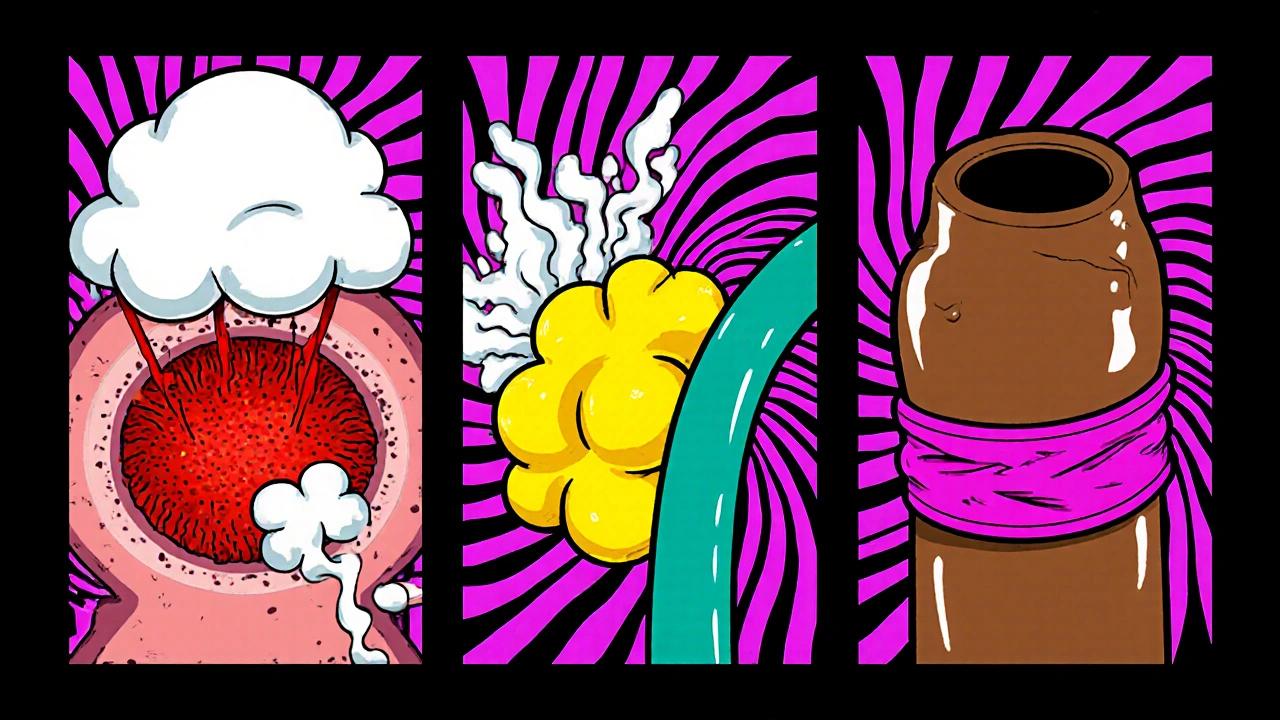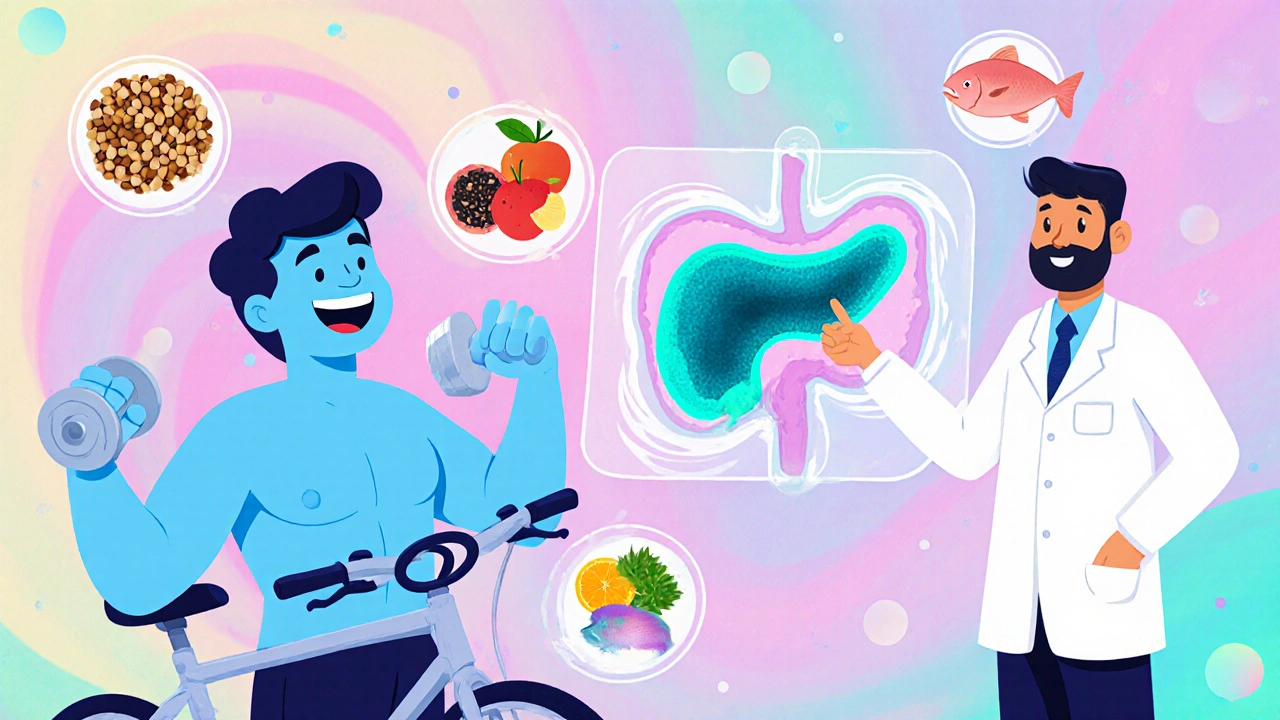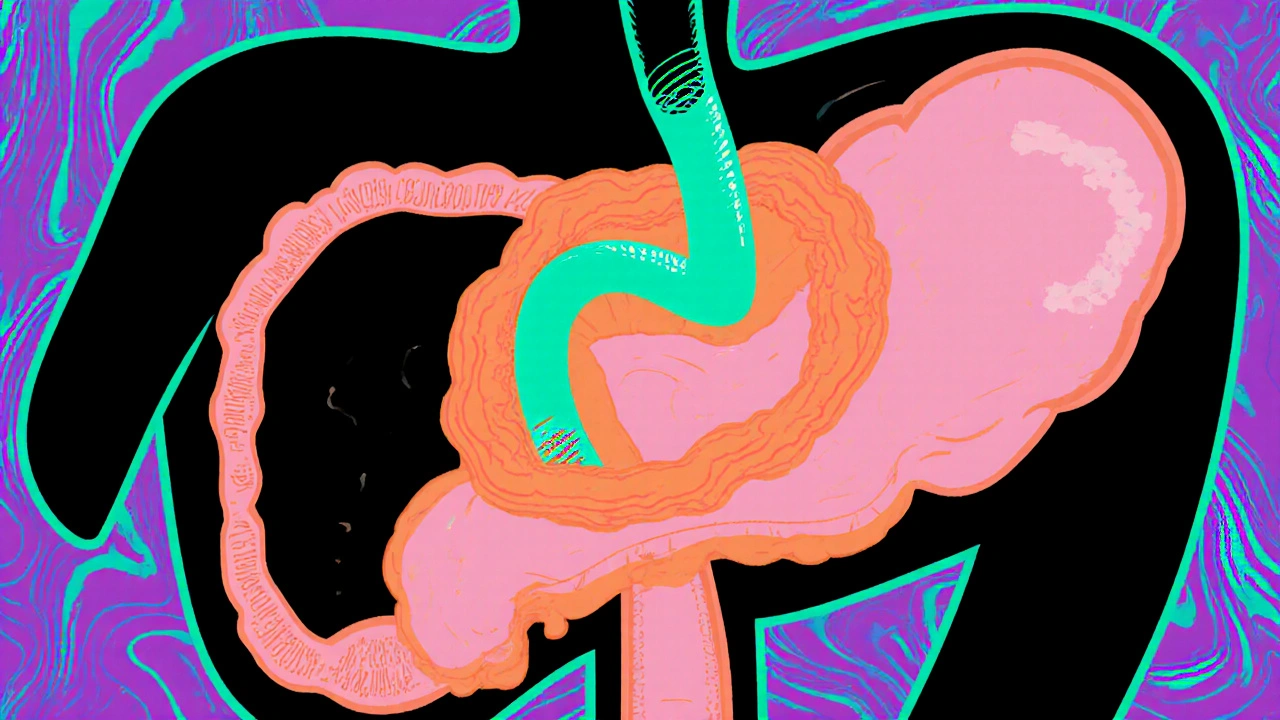Pancreatic Duct Blockage Risk Calculator
When extra body fat piles up, it doesn’t just sit on the hips - it can creep into organs you rarely think about. One of the hidden risks is a higher chance of the pancreatic ducts getting clogged, which can spark pain, inflammation, and long‑term digestive problems.
What is obesity?
Obesity is a chronic condition characterized by excessive fat accumulation that poses a risk to health. It is typically measured by a Body Mass Index (BMI) of 30 or higher. The extra fat changes hormone levels, boosts inflammation, and stresses virtually every organ system, including the pancreas.
Understanding the pancreatic duct system
Pancreatic Duct Blockage occurs when the main duct that carries digestive enzymes from the pancreas into the duodenum becomes narrowed or fully obstructed. When this flow stops, enzymes back up, causing tissue damage and increasing the risk of chronic pancreatitis.
Why excess weight tips the balance
Several mechanisms link excess body fat to duct obstruction:
- Fat‑induced inflammation: High levels of circulating lipids trigger systemic inflammation, which can thicken the walls of the pancreatic ducts.
- Increased pancreatic fat: Fat infiltrates the pancreas itself, squeezing the ductal channels much like a garden hose under pressure.
- Hormonal shifts: Obesity raises insulin and leptin levels, both of which can alter the secretion pattern of pancreatic enzymes, making them more viscous and prone to clumping.
- Gallstone formation: Overweight individuals are more likely to develop gallstones that can migrate into the pancreatic duct system, directly causing blockage.
Key players in the blockage puzzle
Understanding the entities involved helps you see why the problem compounds:
- Sphincter of Oddi - a muscular valve that controls the flow from the pancreatic and bile ducts into the duodenum. Fat‑related inflammation can cause the sphincter to spasm, narrowing the outflow.
- Chronic Pancreatitis - long‑term inflammation that scarred tissue can further constrict ducts.
- Diabetes Mellitus - often a sequel of obesity, diabetes changes the composition of pancreatic secretions, making them thicker.

How doctors spot a blocked duct
Symptoms alone aren’t enough; imaging and labs confirm the diagnosis:
- Blood tests: Elevated amylase or lipase suggest enzyme leakage.
- Ultrasound: Detects pancreatic calcifications and gallstones.
- Magnetic Resonance Cholangiopancreatography (MRCP): Provides a clear view of duct narrowing without radiation.
- Endoscopic Retrograde Cholangiopancreatography (ERCP): Both diagnostic and therapeutic; a stent can be placed to relieve blockage.
Risk comparison: Obese vs. Normal‑weight individuals
| BMI Range | Annual Blockage Rate | Common Complications |
|---|---|---|
| 18.5‑24.9 (Normal) | 0.4 % | Occasional gallstones, mild pancreatitis |
| 25‑29.9 (Overweight) | 0.9 % | Increased gallstone risk, early‑stage duct narrowing |
| 30 + (Obesity) | 2.3 % | Frequent duct obstruction, chronic pancreatitis, higher diabetes prevalence |
Prevention: Turning the tide before blockage starts
The best strategy is to keep excess fat at bay, but there are practical steps anyone can adopt:
- Watch your calories: Aim for a modest deficit of 500 kcal per day to lose about 1 pound per week.
- Boost fiber intake: Whole grains, fruits, and legumes help regulate blood sugar, lowering insulin spikes that affect pancreatic secretions.
- Limit saturated fats: Cut down on fried foods and high‑fat dairy; replace with omega‑3‑rich fish or flaxseed.
- Stay active: At least 150 minutes of moderate‑intensity aerobic exercise each week reduces visceral fat around the pancreas.
- Screen for gallstones: If you’re overweight and have abdominal pain, an ultrasound can catch stones before they travel into the ducts.

When to seek medical help
If you notice any of these red flags, call your doctor promptly:
- Sudden, severe upper‑abdominal pain that radiates to the back \n
- Nausea or vomiting that doesn’t improve
- Unexplained weight loss despite a high‑calorie diet
- Persistent indigestion or fatty stools (steatorrhea)
Living with a blocked duct
Even after a blockage is cleared, the pancreas may stay vulnerable. Ongoing care includes:
- Regular follow‑up imaging every 6‑12 months.
- Enzyme supplements if digestion remains compromised.
- Strict glycemic control for any co‑existing diabetes.
- Continued weight‑management programs to prevent recurrence.
Bottom line
Carrying extra pounds does more than strain your joints; it can choke the tiny tubes that let your pancreas do its job. By understanding the link, tracking symptoms early, and adopting healthier habits, you can keep the ducts clear and protect digestive health for years to come.
Can losing weight reverse an existing pancreatic duct blockage?
Weight loss can reduce the fat surrounding the pancreas and lower inflammation, which may improve duct patency. However, if scar tissue has already formed, medical or endoscopic intervention is usually required.
Are gallstones the main cause of blockage in obese people?
Gallstones are a common culprit, especially in overweight adults, but they’re not the only cause. Fat‑induced inflammation, pancreatic fat infiltration, and sphincter spasms also play significant roles.
What dietary changes help keep the pancreatic ducts clear?
A diet low in saturated fats, high in soluble fiber, and balanced with lean protein reduces lipid buildup and promotes smoother enzyme flow. Adding omega‑3 fatty acids can also curb inflammation.
Is there a genetic link between obesity and duct blockage?
Certain gene variants that affect fat metabolism (e.g., FTO) increase obesity risk, which indirectly raises the chance of duct issues. Direct genetic predisposition to duct blockage is rare.
How often should someone with a history of blockage get screened?
Experts recommend imaging every 6‑12 months for the first two years after treatment, then annually if no new symptoms appear.

Kimberly Lloyd
October 21, 2025 AT 19:12It’s fascinating how something as seemingly innocuous as extra fat can ripple through our biology, reminding us that the body is a tightly knit ecosystem.
When the pancreas feels the pressure of inflammation, it’s not just a medical fact-it’s a quiet signal that our lifestyle choices echo in our inner organs.
Embracing small, consistent habits-like a short walk after dinner or swapping a sugary snack for a piece of fruit-can gradually lighten that burden.
Think of each positive step as a brushstroke that, over time, repaints the larger picture of health.
While the statistics in the article may look daunting, they also highlight the incredible capacity we have to intervene before irreversible damage sets in.
Devendra Tripathi
November 2, 2025 AT 11:00This article overstates the direct causality between obesity and pancreatic duct blockage; correlation does not equal causation.
Many lean individuals develop similar issues due to genetic predispositions or alcohol use, so putting the blame squarely on weight is simplistic.
Moreover, the suggested dietary changes ignore cultural eating patterns and socioeconomic constraints.
A more balanced view would acknowledge that obesity is one piece of a multifactorial puzzle, not the lone villain.
Rachel Valderrama
November 14, 2025 AT 03:48Oh great, another reminder that my love for pizza might someday clog a tiny tube inside me.
Thanks for the guilt trip, but at least now I know I can blame my pancreas when the night after a big feast feels rough.
Maybe I’ll start a “pizza‑free” diet tomorrow… or maybe I’ll just enjoy the sarcasm of it all.
Brandy Eichberger
November 25, 2025 AT 20:36One must appreciate the elegance of the pancreatic ductal architecture before condemning it to the blunt instrument of excess adiposity.
The article, while thorough, could have benefited from a more scholarly discourse on the biophysical properties of viscous enzyme secretions.
Nonetheless, the friendly tone makes the complex subject approachable, a commendable feat for a lay‑readers’ platform.
I look forward to further elucidations that blend scientific rigor with accessible prose.
Eli Soler Caralt
December 7, 2025 AT 13:24Honestly, the link between belly‑fat and duct ablockage is more nuanced than the piece lets on… cuz the pancreas can adapt, you know? 🤔
Yet the chronic inflammation pathway is real, and it’s not just about “eating salads”.
The pseudo‑philosophical notion that our bodies are tiny universes battling our habits is kinda poetic, even if it sounds like a TED‑talk cliché. 😅
So yeah, losing weight can help, but don’t expect a miracle overnight; it’s a marathon, not a sprint. 🍏
Eryn Wells
December 19, 2025 AT 06:12Your body is a beautiful tapestry of cultures, genetics, and daily choices. 🌍
Understanding how excess fat can strain the pancreas helps us all make kinder decisions for ourselves and our loved ones.
Remember, small steps like adding a fiber‑rich side dish or a brisk walk after dinner can create big ripples in health.
If you ever feel overwhelmed, reaching out to a community group or a nutritionist can provide much‑needed support.
Keep sharing knowledge-together we can demystify these medical mysteries! 😊